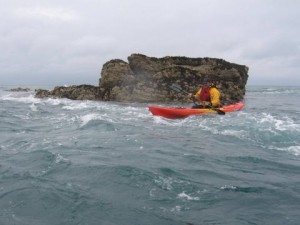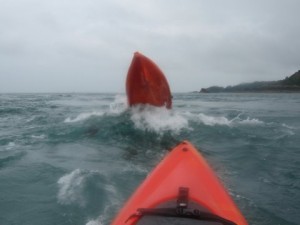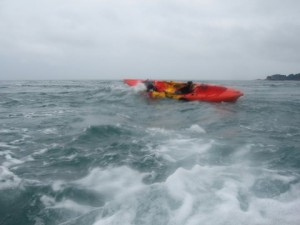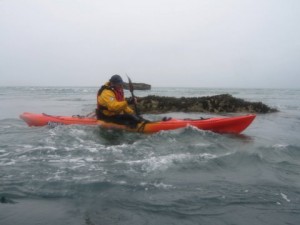Sit on top kayak fishing and self rescue training in tide races
A few days ago I got a call from Keith, a Bass fishing guide who has discovered just how good Sit on top kayak fishing is.
It soon became clear that the sort of areas he wants to fish are often the very spots most prefer to stay well clear of.
Sitting in eddies behind rocks and near overfalls might not be everyone’s idea of a good fishing spot but Keith has different ideas. I’ll leave his other favourite method of fishing for you to read about on his excellent website and blog. Lets just say these guides are serious about fishing and are breaking new ground. I suspect that in a previous life Keith was a Bass.
Keith’s knowledge of the waters around Jersey is impressive, as is his water confidence, so by the time we’d thrashed out an action plan for his skills development it was petty clear we were in for a great bit of fun afloat at la tour de Rozel on a 34ft tide 3 hours after low. Just the place to try ferry glides, break ins and self rescues should things go a bit wrong.
Now this is not normally a spot I’d take a paddler into without some pre training but Keith was game to test his limits. He also wanted to discover some of the issues of using a sit on top sea kayak in this sort of water. Better to know the limits before you start playing with the ocean.
This was an opportunity to test a few of the theories and ideas that seem to litter some kayak fishing forums.
If you are going to do some serious kayak fishing in challenging waters keep things simple and develop your kayak skills and techniques.
All the safety gear may look good but without some training it may become a big hindrance. Remember to practice!
As Keith mentions in his blog if you are going to go kayak fishing make very sure you can deal with a capsize.
Well we had a few good capsizes in some pretty challenging water and lots of fun getting used to working the eddies. There was also a couple of incidents to contend with, like the time the paddle leash got tangled around his foot. No big deal when you know what has happened and your have safety cover near by. However, it is a different story if you are alone.
One thing we quickly decided to avoid was to attach a leash from the kayak to the paddler. This coupled with a paddle leash was asking for a lot of nasty tangles in the event of a capsize in rough water. We reckoned that in a capsize you’d quickly grab the kayak anyway.
Having the paddle leash frees up the hands to get on with the job of getting yourself back on board.
Some photos are a bit fuzzy due to the poor light. It was also a bit bumpy trying to get the shots.




